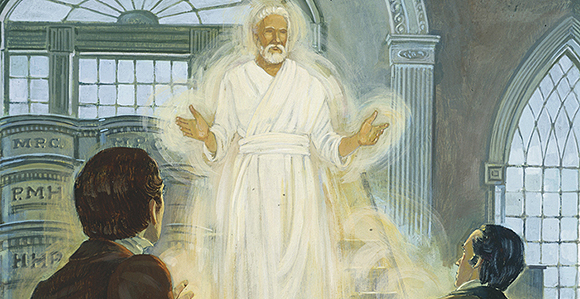Viewpoint: Key Events in 1836 and 2018 Occurred on Easter Sunday
Contributed By the Church News

We are privileged to witness the further unfolding of the Restoration for which the stage was set 182 years ago with the visitations from the Savior, Moses, Elias, and Elijah.
Article Highlights
- One of the most beautiful Easter Sundays occurred in 1836 when the Savior, Moses, Elias, and Elijah visited the Kirtland Temple.
- The Restoration further unfolded this Easter weekend as we sustained our prophet and two new Apostles.
On Easter Sunday of April 3, 1836, while Christianity at large was celebrating His Resurrection and Atonement, the Savior of the world appeared in vision to two of His anointed servants.
The setting was the newly dedicated Kirtland Temple in Ohio. The Prophet Joseph Smith recorded the occasion in these words:
“In the afternoon, I assisted the other Presidents in distributing the Lord’s Supper to the Church, receiving it from the Twelve, whose privilege it was to officiate at the sacred desk this day. After having performed this service to my brethren, I retired to the pulpit, the veils being dropped, and bowed myself, with Oliver Cowdery, in silent and solemn prayer” (see heading to D&C 110).
After the prayer, the veil was taken from their minds, and they saw the Lord standing before them on the breastwork of the temple pulpit.
In phrasing reminiscent of John’s Book of Revelation, Joseph Smith reported, “His eyes were as a flame of fire; the hair of his head was white like the pure snow; his countenance shone above the brightness of the sun; and his voice was as the sound of the rushing of great waters” (verse 3).
“I am the first and the last,” the Lord declared. “I am he who was slain; I am your advocate with the Father” (verse 4).
Accepting the holy house they had just completed, the Lord declared He would manifest Himself to His people in mercy and pledged that blessings would be poured out upon them.
Marvelous as it was, it was not the only divine manifestation Joseph and Oliver would receive that day. Thereafter, Moses appeared and committed to them the keys of the gathering of Israel, an essential work preparatory to the Second Coming of the Savior in glory.
Then came the appearances in turn of Elias, who committed the dispensation of the gospel of Abraham whereby all generations would be blessed, and of Elijah, to turn the hearts of the fathers to the children and of the children to the fathers, making it possible for generations of families to be sealed together through temple ordinances.
“Therefore, the keys of this dispensation are committed into your hands; and by this ye may know that the great and dreadful day of the Lord is near, even at the doors,” (verse 16) Elijah said on that occasion.
The events of that Easter Sunday in 1836 thus set the stage for the great work of the latter-day dispensation in which the world would be made ready for Christ’s glorious return.
It was thus a memorable Easter for the members of Christ’s restored Church, observing not only the gift of life and salvation provided to all mankind by the Redeemer, but the bestowal of sacred keys that would make possible the work of the last dispensation.
Strikingly, April 3, 1836, should be meaningful to Latter-day Saints for another reason.
In our theology, Easter is associated with the ancient Israelite celebration of Passover. Both observances are rich in symbolism pertaining to the sacrifice of the Lamb of God to bring deliverance and salvation to the Lord’s covenant people.

A traditional part of the annual Jewish observance of the Passover ceremony pertains to the prophesied coming of Elijah. Typically, during the Passover feast, or Seder, a place is set at the table for Elijah, and at a certain time during the meal, the door is opened for the prophet to enter. The origin of that tradition is lost to history, but it seems likely it has some theological significance in the Passover observance.
As it happened, April 3 was the second day of the Passover season in 1836. So, remarkably, Elijah the prophet did indeed return during Passover (see Stephen D. Ricks, “The Appearance of Elijah and Moses in the Kirtland Temple and the Jewish Passover,” Brigham Young University Studies, Fall 1983, pp. 483-86).
For us, then, the prophesied coming of Elijah is a sacred thread that runs through the Feast of the Passover, the salvation of the human family celebrated at Easter, and the sublime events that occurred in the Kirtland Temple on April 3, 1836.
That is nice to ponder on this Easter weekend as we take in the proceedings of the 188th Annual General Conference, for this too will be a memorable Easter. At this historic conference, we will experience a solemn assembly during which we sustain for the first time the newly called First Presidency. Furthermore, two vacancies in the Quorum of the Twelve Apostles were filled, and we had opportunity to sustain two more men who will devote the rest of their lives to being special witnesses of the divinity of the Lord Jesus Christ in all the world.
We thus are privileged to witness the further unfolding of the Restoration for which the stage was set 182 years ago with the visitations from the Savior, Moses, Elias, and Elijah.
How blessed we are to be living in a day when we can see the fulfillment of the ancient prophecy: “And it shall come to pass in that day, that the Lord shall set his hand again the second time to recover the remnant of his people. …
“Therefore, behold, I will proceed to do a marvellous work among this people, even a marvellous work and a wonder” (Isaiah 29:14).
